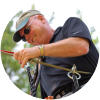The long-ago sounds associated with Valley Forge National Historical Park once included barked military commands, the crackle of campfire, the whinny of horses and the chatter associated with 12,000 soldiers living in an encampment.
It now consists of the occasional bark of a dog on a walk, the steady drone of traffic, the rustle of trees and the rhythmic thudding of a solo jogger's feet.
But if the timing is right, another sound accompanies visitors: music of the bells from Washington Memorial Chapel. And should you find yourself enjoying the open space while a melody floats toward you on a gentle breeze, know that it's not being produced by a recording or other automation.
It is coming from the hands - and feet - of carillonneur Doug Gefvert.
Since taking the position in 1999, Gefvert begins each day at the console with a long climb up the 120-foot National Patriots Bell Tower, where the spiral concrete staircase is as dizzying as the one in Hitchcock's Vertigo. Along the way, a series of windows provide illumination, as well as trivia written on small plaques: For instance, the largest bell weighs 8,000 pounds and the original set included 14 bells, one for each colony plus one for the union.

About three-quarters up is Gefvert's office; it is a tidy space with file cabinets for music and a "practice carillon" that enables him to rehearse without broadcasting his rehearsal to a large portion of a national historical park. Both the ceiling and the floor feature large, square trapdoors and a hand-cranked winch. Their purpose, says Gefvert, is for replacing a bell, should that become necessary. "It's not like we can dis-assemble the tower to take a bell out," he explains.
From the office, it is just a few more circles of the staircase to reach the tower's pinnacle. A small catwalk connects to a locked, square room that contains the carillon itself. Inside the console comprises foot pedals that control the larger, lower-pitched bells and a "keyboard" with large, wooden pegs called batons. A series of cables and springs enable the carillonneur to sit at the bench and play the 58 tuned, bronze bells.

The instrument is surprisingly agile; Gefvert swings into a three-quarter-time piece that has him pounding the batons in a blur. But it also has subtlety. Volume is controlled by the force of the fist-strikes on each baton. The harder the hit, the louder the ring.
"This is an instrument that changes tone based on a vast number of variables," Gefvert explains. "Humidity, temperature, even wind speed can affect the sound waves and how they reach the ear." The largest bell, he says, can be heard across the Grand Parade, all the way to the National Memorial Arch. The smallest bell, a mere 13 pounds ("Still something I wouldn't want dropped on my foot," Gefvert laughs), can barely be heard at the base of the tower.
Music written for carillon primarily features it as a solo instrument, but Gefvert has also accompanied brass, voice, bagpipes and even the spoken word. "I had a cell phone to my ear," he says, "with a narrator down below. I could hear what he was saying and provide appropriate background music to match his words and cadences. He paused along the way, giving me the opportunity to bring out the carillon by itself. And then I would quiet down the accompaniment so that his narration could continue. The back-and-forth between us turned out to be a very memorable and moving presentation."

Gefvert and a rotation of guest musicians provide a regular carillon concert series on Wednesdays at 7:30 p.m. throughout July and August, a tradition that is now 62 years old. Picnicking is encouraged, with the Chapel Cabin Shop open for refreshments. The concerts are free.
In addition, the carillon rings out every Sunday, before and after the 10 a.m. Sunday Chapel Service and in concert at 12:30 p.m. (weather permitting).
Between the familiar hymns and patriotic songs that are often part of the carillon repertoire, there's a good chance you'll hear a tune that "rings a bell."






